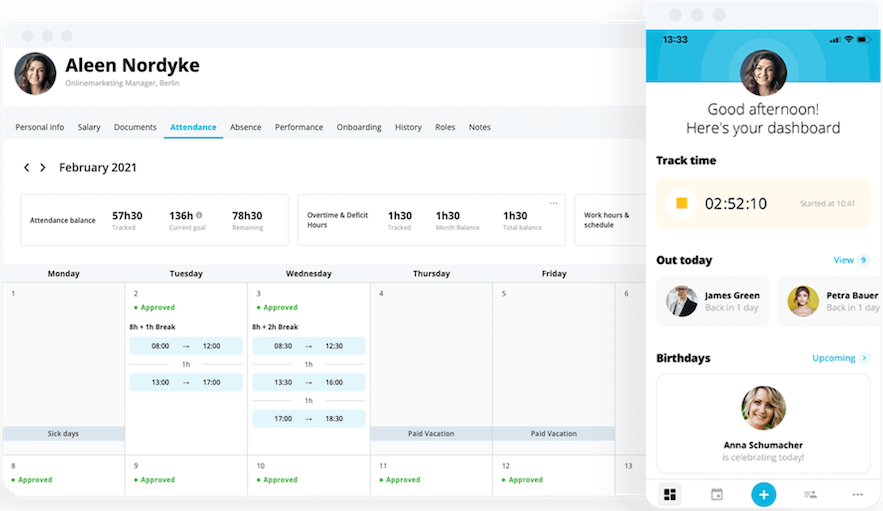
People Strategy Guidebook
A free guide to help power your next great people strategy.
Download our guide to developing your organization’s own people strategy today.An overview of flexible working practices & policies

What is flexible working? And, how can organisations make it a success? Let's dig into things like flexible working requests and policies to get to the heart of what employees crave and expect. And how employers can meet those expectations.
Need somewhere to store contracts? Learn about Personio’s digital employee file today.What is flexible working?
Flexible working is work designed to suit the unique needs of a specific employee. It is a way of working that caters to an employee's chosen style of working.
In general, a flexible working arrangement is designed to adjust to the needs of specific employees. It typically results in changes to an employees working hours or location.
For most organisations, flexible working is an alternative to more traditional ways of working. Employees have a right to request it.
What is a flexible working request?
Employees have a right to request flexible working. An employee may make a flexible working request if they want to change their working hours or from where they work.
Prior to the Covid-19 pandemic, these requests were typically few and far between, but recent data shows that now around 1 in 4 workers plan to be fully remote in the near future.
How is flexible working changing in the UK?
A new bill now receiving royal assent is set to redefine how flexible working requests operate in the UK. The new law will amend the Employment Rights Act of 1996 to change the current right to request flexible working.
This would include:
New requirements for employers to consult with employees before rejecting any sort of flexible working request.
The permission to make two statutory requests in a 12-month period. This is in contrast to only one current request able to be made.
A reduction in waiting times for decisions from three to two months.
The removal of requirements that employees have to explain what effect the change would have on the employer in question (and how to deal with it).
Most importantly, employees will now be able to make a flexible working request from day one of a new job. This is due to influence 2.2 million works in the UK.
What are types of flexible working?
There are six unique types of flexible working worth considering. They include:
Part-time working | An employee reduces their hours from a full-time to a part-time capacity |
Working from home | Employees change their location to work from home or remotely (not in office) |
Job sharing | Where a full-time role is split up between two employees sharing hours and responsibilities |
Compressed hours | Employees working a normal load of hours across less days of the week |
Flexi-time | An employee working hours that sit outside of an employer's "core hours" (like 9-5, for instance) |
Phased retirement | When a mature worker can reduce their hours prior to retirement |
These are just some flexible working examples, but if we think about this type of work very holistically, it is essentially any way that an employer can help an employee perform better in their role outside of the traditional framework of work.
Can parents make a flexible working request?
Definitely! Whether you are a working parent, a caregiver, or returning from maternity leave, every employee (within the 26-weeks rule) has the right to make a flexible working request.
The benefits of flexible working for UK SMEs
Alternative work patterns are on the rise, thanks in part to flexible working rights in countries like the UK. In Europe, between 50 and 90 per cent of employees can now take advantage of these working practices.
In the U.S., nearly 30 per cent of employed Americans have the option to work at least partly from home. The numbers keep rising, and with good reason.
Myriads of studies show the benefits of flexible working for companies and employees:
Organisations gain access to a larger talent pool when they can hire people in other locations.
A flexible working policy can even lower overhead costs by reducing office space sizes and utility costs.
Employees can save time, reduce transportation and child care costs, and work when they are most efficient.
There is often greater employee engagement, increased productivity, and less absenteeism and turnover.
Dive Even Deeper Through Our People Strategy Guide

Gain insights directly from Personio's Chief People Officer on how to build a better people strategy roadmap today. Grab your copy, for free, right now.
Download For FreeWhat are the drawbacks of flexible working?
It is quite clear that the businesses of the future need to have flexible working in place. For many organisations emerging from the pandemic, it is simply table stakes. But, the downsides are finding the time for HR to manage flexible work, flex employees, and flexible working requests.
So, the main downside of all this is the lack of time. But, when HR has a solution in place, like an HR system, it can afford them the time to truly focus on flexible working as a business topic and objective!
How do you create a flexible working policy?
When it comes to flexible working, it is up to HR to provide the right structure and framework to make it efficient and successful for everyone.
One of the ways they can do this is through HR software, which can ensure that operational excellence is ensured (and flexible work can be handled strategically).
From advocating for a flex policy through to creating the structures around it, HR plays a leading role in the success of flexible work arrangements. Setting up these practices is a multi-step process and it will differ for each organisation.
Here’s a roundup of best practices we’d recommend:
1. Perform a needs assessment
Start with an organisational assessment to see where things stand. Especially when it comes to a back-to-the-office policy or a phased return to work, it helps to take the temperature of your organisation.
To see where people stand, ask them questions in an employee pulse survey. Consider questions like:
How many days, on average, would you want to work in the office?
Do you want to work in an office environment at all?
Would you be interested in a compressed hours schedule (regular hours over four days versus five)?
Would you appreciate a flexible working request framework or policy to be made easily available?
Depending on the size and culture of your company, questions and employee surveys like these can really help uncover how people feel, what they would prefer, and what is going to be best for business. So, this is the perfect place to start.
2. Create a flexible working policy
Regardless of how your organisation feels, you need to provide clarity to every worker. That means having a flexible working policy and process, to provide clear guidelines on and procedures for how these arrangements ‘work.’
For example, you should consider stating:
If jobs with flexible hours will apply to all staff.
If employees who want this benefit need to submit a flexible working request.
And, of course, HR needs to ensure that the policy is in compliance with UK employment law.
3. Train your line managers
Managing flexible workers or managing remote teams is crucial to the success of a policy. But it’s different than managing people in a traditional work setting. Arrange training for managers on topics like:
Overseeing remote staff
Managing virtual teams
Evaluating the performance of remote employees
Give your managers and leads the opportunity to be just as successful with flexible work. After all, it is definitely going to have an effect on the way they work, and how productive they feel, so HR should be there to fully support them, too.
4. Implement a tracking tool
The perception of fairness is sometimes a concern with flexible working policies. H
ow can organisations ensure that home-based, part-time or employees with flexible working hours are really doing their jobs? By making attendance tracking easy and accessible, that’s how.
Provide a self-service tool that lets employees log their attendance and absences, and lets managers keep track of this data. This will not only empower employees to track their time, but will result in accurate HR reporting and analytics.
5. Establish communication tools and working norms
The Covid-19 pandemic has revealed the necessity for communication tools, like Slack or Zoom. So, first off, ensure that everyone has access to team collaboration software for instant messaging, remote conferencing, project management, and document sharing.
As HR managers (and flex employees too), make sure you also have an accessible tool to keep track of employee data. It’s also good to encourage managers to set up communication rules, such as daily or weekly "check-ins” with individual employees, and monthly team meetings (virtual or in-person).
This helps keeps everyone in touch, on point and accountable.
6. Raise awareness
Finally, HR needs to raise awareness among staff of their right to request flexible working hours or location, and the advantages that this policy brings. You should also highlight this benefit as part of your employer branding strategy and employer value proposition.
Is flexible working right for your team?
It truly depends. Flexible working may bring with it a huge amount of benefits, but if you don't have a way to truly manage your workforce it will never succeed. Personio is an all-in-one HR software solution designed to help upgrade your people operations.
Personio can help recruit, onboarding, manage, develop and pay your employees more easily. Click here for the full breakdown of the Personio advantage.
Disclaimer
We would like to inform you that the contents of our website (including any legal contributions) are for non-binding informational purposes only and does not in any way constitute legal advice. The content of this information cannot and is not intended to replace individual and binding legal advice from e.g. a lawyer that addresses your specific situation. In this respect, all information provided is without guarantee of correctness, completeness and up-to-dateness.

